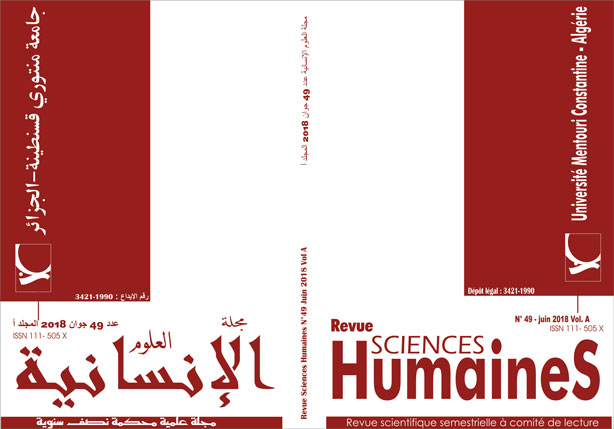Culture influence on Algerian Students’ EFL Writing An Insight into Teachers’ Practices
Keywords:
ESL, EFL writing, culture, contrastive, intercultural rhetoric, awarenessAbstract
The paper discusses a qualitative study that aims at exploring teachers’ perceptions and attitudes toward the role of culture in the foreign language writing class. It is based on the hypothesis that teachers of writing at the Ecole Normale Supérieure of Constantine (ENSC) have little awareness of the role of culture in the foreign/ second language writing class, that they have little knowledge of contrastive/ intercultural rhetoric, and that their teaching instruction (methodology, feedback, evaluation) does not reflect any culture consciousness or contrastive/ intercultural rhetoric use. To verify this hypothesis, interviews were conducted with three, experienced teachers of written expression at the department of English at the ENSC. Teachers’ responses have confirmed the aforementioned hypothesis.
Downloads
References
Al Hamzi, S. H. & Scholfield, P. (2007) Enforced Revision with Checklist and Peer Feedback in EFL Writing: The Example of Saudi University Students, in Scientific Journal of King Faisal University (Humanities and Management Sciences) Vol.8 No.2 1428H (2007), pp. 237- 267.
Allaei, S. K. & Connor, U. (1990) Exploring the Dynamics of Cross-Cultural Collaboration in Writing Classrooms, The Writing Instructor, fall 1990, pp. 19-28
Alodwan, T. A. & Ibnian, S. S. K. (2014) The Effect of Using the Process Approach to Writing on Developing University Students’ Essay Writing Skills in EFL, in Review of Arts and Humanities, June 2014, Vol. 3, No. 2, pp. 139-155 .
Berman, R. (1994) Learners' Transfer of Writing Skills Between Languages, TESL Canada Journal/ Revue , Vol. 12, No.1, Winter 1994, pp. 29- 46
Bourouba, N. (2012) Teaching Writing Right: Scaffolding Writing for EFL/ESL Students Case Study: Algerian EFL Secondary School Students Challenges and Opportunities, Unpublished Master dissertation, Graduate Institute for International Training, World Learning, Brattleboro, Vermont, USA
Chlopek, Z. (2008) The Intercultural Approach to EFL Teaching and Learning, English Teaching Forum, N. 4, pp. 10- 19
Colombo, L. (2012) English Language Teacher Education and Contrastive Rhetoric, ELTED, vol.15, Winter 2012, pp. 1- 6
Connor, U. (1996) Contrastive Rhetoric: Cross-Cultural Aspects of Second Language writing. New York: Cambridge University Press
------------- (2004) Intercultural Rhetoric Research: Beyond Texts, Journal of English for Academic Purposes 3 (2004), pp.291–304
------------- (2008) Mapping Multidimensional Aspects of Research: Reaching to Intercultural Rhetoric, in U. Connor, E. Nagelhout, & W. Rozycki, (Eds.), Contrastive Rhetoric: Reaching to Intercultural Rhetoric, Benjamins Press, pp. 299- 315
------------- U. (2011) Introduction, Connor, U. Intercultural Rhetoric in the Writing Classroom, the University of Michigan Press ELT. Pp. 1-10. Retrieved from: http://www.press.umich.edu/titleDetailDesc.do?id=3488851
Connor, U., & Traversa, A. (2014). The Role of Intercultural Rhetoric in ESP Education. Paper presented at the CELC 2014 Symposium on Culture, Cross-Cultural Communication, Intercultural Communication.
Darus, S & Ching, K. H (2009) Common Errors in Written English Essays of Form One Chinese Students: A Case Study, in European Journal of Social Sciences – Volume 10, Number 2 (pp. 242- 253)
de Jong, E. J. & Harper, C. A. (2005) Preparing Mainstream Teachers for English-Language Learners: Is Being a Good Teacher Good Enough?, Teacher Education Quarterly, Spring 2005, pp. 101- 123
Edlund, J (2003) Non-Native Speakers of English, in I. Clark (ed.) Concepts in Composition: Theory and Practice in the Teaching of Writing. London and Mahwan, NJ: Lawrence Elbaum Associates, Publishers, pp. 363-387
Kaplan, R. B. (1966) Cultural Thought Patterns in Intercultural Education, in Language Learning 16 (1-2), Blackwell Publishers, pp. 11- 25
------------ (1988) Contrastive Rhetoric and Second Language Learning: Notes towards a Theory of Contrastive Rhetoric, in A. C. Purves (Ed.), Written Communication Annual (Vol.2) Writing across Languages and Cultures. Newbury Park, CA: Sage Publications. pp. 275–304
------------ (1990.) Writing Styles of Second Language Learners. Deseret Language and Linguistic Society Symposium, vol. 16 Iss. 1, pp. 2- 23
Kramsh (2013) Culture in Foreign Language Teaching, Iranian Journal of Language Teaching Research, 1(1), (Jan., 2013), pp. 57-78
Lee (2009) Treating Culture: What 11 High School EFL Conversation Textbooks in South Korea Do, English Teaching: Practice and Critique May, 2009, Volume 8, Number 1, pp. 76- 96
Leki, I. (1992) Understanding ESL Writers. A Guide for Teachers. Portsmouth, NH: Boyton/Cook Publishers.
Lincoln, F. & Ben Idriss, A. (2015) Teaching The Writing Process As A First And Second Language Revisited: Are They The Same?, Journal of International Education Research – Second Quarter 2015, Volume 11, Number 2, pp. 119- 124
Matsuda, P. K. (1997) Contrastive Rhetoric in Context: A Dynamic Model of L2 Writing, Journal of Second Language Writing, 6 (1 ), pp. 45-60
Matsumoto, K. (1995) Research Paper Writing Strategies of Professional Japanese EFL Writers, TESL Canada Journal Revue TESL du Canada, Vol. 13, No.1, Winter 1995, pp. 17- 26
Nishi, K (n.d.) Contrastive Rhetoric and its Recent Studies: Implications for the Current Teaching of English Writing at Universities in Japan. Retrieved from: http://www.kyoto-seika.ac.jp/researchlab/wp/wp-content/uploads/kiyo/pdf-data/no30/nishi.pdf
Nissila, S.P. (1997) Raising Cultural Awareness among Foreign Language Teacher Trainees, in Byram, M and G. Zarate (eds) The Sociocultural and Intercultural Dimension of Language Learning and Teaching, Council for Cultural Co-operation, pp. 55- 72
Nunan, D. & Choi, J. (2010) Language, Culture, and Identity. Framing the Issue, in C. Kramsh (ed.) Language and Culture. Reflective Narratives and the Emergence of Identity, Routledge, pp. 1-13
Nunan, D. (1989) Designing Tasks for the Communicative Classroom, Cambridge University Press
Oberheu, N. (n.d.) From Contrastive to Intercultural Rhetoric: Why Studying Intercultural Rhetoric is Important for MA TESL/TEFL Students. Retrieved from: https://nicholeoberheu.com/wp-content/uploads/2012/05/From-Contrastive-to-Intercultural-Rhetoric-Why-Studying-Intercultural-Rhetoric-is-Important-for-MA-TESL-TEFL-Students1.pdf
Raimes, A. (1985) An Investigation of How ESL Students Write, Paper presented at the Annual Meeting of the Teachers of English to Speakers of Other Languages (19th, New York, NY, April 9-14, pp. 1-29
Scarino, A. & Liddicoat, A. J. (2009) Teaching and Learning Languages. A Guide, Australian Government, Department of Education, Employment and Workplace Relations
Silva, T. (1993) Toward an Understanding of the Distinct Nature of L2 Writing: The ESL Research and Its Implications, TESOL Quarterly, Vol. 27, No. 4. (Winter, 1993), pp. 657-677.
Soter, A. O. (1988) The Second Language Learner and Cultural Transfer in Narration. In A.C. Purves (Ed.), Written Communication Annual (Vol.2), Writing Across Cultures (pp.177-205). Newbury Park, CA: Sage Publications.
Zamel, V. (1983) The Composing Processes of Advanced ESL Students: Six Case Studies, TESOL Quarterly, Vol. 17, No. 2. (Jun., 1983), pp. 165-187.
Zhang, J. (2008) A Comprehensive Review of Studies on Second Language Writing, HKBU Papers in Applied Language Studies Vol. 12, 2008, pp. 89- 122
















